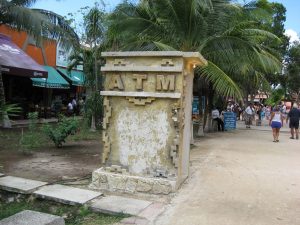Things You Can't Get in Mexico and Should Bring to Mexico
What Should I Bring With Me When I Move to Mexico?
 What should you bring with you when you move to Mexico?
What should you bring with you when you move to Mexico?
The short answer is: “It depends”.
The longer answer is: It depends on:
- Where you will be living in Mexico.
- How comfortable you are with ordering products online.
- How attached you are to your furniture and other items/keepsakes.
- How important your home country branded products are to you.
- Things you may not easily find in Mexico.
Where you will be living in Mexico.
If you will be living within a short (1+/- hour) drive to a larger city, then you’ll most likely have a wide variety of shopping options. Anything you can buy at these stores, you won’t need to bring with you.
Although you should know that any and all products shipped from the U.S. or Canada to stores in Mexico are subject to additional customs duties and a 16% IVA (Sales Tax) when they cross the border into Mexico. These additional fees and taxes will increase the retail prices of these products in Mexico.
General Merchandise:
Costco: 34 stores in 18 Mexican states Sam’s Club: 88 stores in 29 Mexican states
Walmart: 72 stores in 28 Mexican states Home Depot: 74 stores in 24 Mexican states
Best Buy: 10 stores in 5 Mexican states
Major Grocery Stores:
Soriana: 824 stores Chedraui: 138 stores Mega: 30 stores
How comfortable you are with ordering products online.
If you’re comfortable with ordering products online, then you’ll have several good options when you’re in Mexico.
amazon.com ships many different products directly to Mexico from the U.S. (although you will still pay the customs duties and Mexican sales tax on these products).
amazon.com.mx offers many (but certainly not all) of the same products available on its U.S. website. Most of these products are stocked and shipped directly from Amazon MX to your home in Mexico, which makes the shipping time shorter than ordering from the Amazon US website.
You can also order directly from costco.com.mx just like you do in your home country.
You will be surprised by how many dozens of online retailers in the U.S. will ship directly to Mexico and/or have a Mexican website that you can order from directly.
There is also mercadolibre.com.mx which is like a Mexican version of Amazon.
How attached you are to your furniture and other items/keepsakes.
There are many high quality, but affordable, furniture stores all across Mexico – from tables and chairs to sofas, desks, cabinets, etc. And, of course, there are always custom furniture makers in most mid-to-large cities and towns who can make you exactly what you want at very reasonable prices.
But, if you have new furniture, or just furniture that you love and want to bring with you, that’s ok too. Maybe you have a favorite “easy chair” or a favorite bedroom suite that you just can’t part with. Or maybe you want to bring items that have sentimental value like family heirlooms (furniture, artwork, quilts, sculptures, etc.) that mean a lot to you. That’s ok too.
Just remember that you may be moving to a location in Mexico that may have a very different climate than where you live now. This new climate may not be “friendly” to the furniture and other things you want to bring with you. For example, living on a coast in Mexico where the climate is hot and humid for many months of the year could damage your current furniture. The heat and humidity can often warp or crack furniture made of wood. The salty ocean air rusts and corrodes everything made of metal – including your outdoor patio furniture, as well as the electrical wiring in your house and your vehicle, metal doors and window frames, light fixtures, kitchen appliances and even your computer and other electronic devices. Just be sure that what you’re bringing with you will be “climate friendly” where you will be living in Mexico.
How important your home country branded products are to you.
Ok, you may not easily find Vegemite or Poutine at your local grocery store or restaurant, but if finding branded products from your home country is important to you, then you do have some very good options IF you live near a large city in Mexico. But, they WILL be more expensive than what you’re used to paying in your home country (due to shipping costs, duties and Mexican sales tax).
For example, there are U.S.-equivalent shopping malls throughout Mexico where you will find popular U.S. and worldwide brands. In Guadalajara (Mexico’s 2nd largest city), you find just about everything you’ll ever want in these 2 shopping malls.

There are also popular restaurants at these malls:
Applebee’s, Chili’s, McDonalds, Outback, P.F. Changs, Dairy Queen, Denny’s, Cheesecake Factory, Hooters, Carl’s Jr., Krispy Kreme
And there are similar upscale shopping malls throughout Mexico, including: Cancun, Tulum, Mazatlan, Puerto Vallarta, Mexico City and many more.
Things you may not easily find in Mexico.
If you’re a woman with a shoe size larger than an 8 or a man with a shoe size larger than a 10, then you will most likely have a problem finding shoes/sandals/boots in your size locally.
If you wear large or tall clothing, then you will most likely have a problem finding clothes in your size locally.
If you like down pillows, 600+ thread count all-cotton sheets, soft/fluffy all-cotton towels or a soft mattress (Mexican mattresses are available in either “hard” or “rock hard”), then you will most likely have a problem finding this type of bedding locally.
If you have countertop kitchen appliances (mixers, blenders, crock pots, steamers, bread makers, etc), that you love, then you’ll probably want to bring them with you. You will most likely have a problem finding these types of kitchen appliances locally.
If you have favorite pots & pans and cutlery that you love, then you’ll probably want to bring them with you. You will most likely have a problem finding these types of cooking utensils locally.
You will also want to bring your computers/laptops, tablets and mobile phones with you. Finding U.S. brands of these products is possible, but more expensive in Mexico due to additional shipping costs, duties and taxes associated with importing these products into Mexico. Also know that computers available for sale at retail stores in Mexico will have Spanish operating systems and Spanish language keyboards (with ñ, á, upside down ? and ! keys, for example).
The best advice on what to bring with you to Mexico is to just ask Chuck at Best Mexico Movers. He’s seen and done it all and can give you the best advice based on his own and his clients’ experiences.
— Lee Steele, Lake Chapala, Jalisco, Mexico


 Check the expiration dates on everything, including your:
Check the expiration dates on everything, including your:


 A “foreign transaction fee” is the amount your card will charge you in order to exchange the pesos you used the card for to make a purchase in Mexico into the dollars your credit card company uses to charge you on your account. Please check to see that any credit card you will use in Mexico has a zero foreign transaction fee.
A “foreign transaction fee” is the amount your card will charge you in order to exchange the pesos you used the card for to make a purchase in Mexico into the dollars your credit card company uses to charge you on your account. Please check to see that any credit card you will use in Mexico has a zero foreign transaction fee.
 Lots of people who live in Mexico don’t have a Mexican bank account. Instead, they pay everything via cash or credit card and for larger purchases, via PayPal, wire transfers or ACH (which is like a bank transfer, but generally much less expensive and faster). When they want pesos, they use their debit card at a Mexican ATM machine.
Lots of people who live in Mexico don’t have a Mexican bank account. Instead, they pay everything via cash or credit card and for larger purchases, via PayPal, wire transfers or ACH (which is like a bank transfer, but generally much less expensive and faster). When they want pesos, they use their debit card at a Mexican ATM machine.
 It won’t be all that unusual for you to want to transfer from US or Canadian dollars to Mexican pesos, perhaps to pay someone more money in Mexico than you have in cash. Also, if you decide to get a Mexican bank account, you’ll also have to fund it. If you do this through a bank-to-bank transfer, you can do it through your bank, or alternatively, you can try the service I use, along with lots of other expats: Transferwise.
It won’t be all that unusual for you to want to transfer from US or Canadian dollars to Mexican pesos, perhaps to pay someone more money in Mexico than you have in cash. Also, if you decide to get a Mexican bank account, you’ll also have to fund it. If you do this through a bank-to-bank transfer, you can do it through your bank, or alternatively, you can try the service I use, along with lots of other expats: Transferwise.
 Not many people are diligent about their passwords. Maybe you’re one of them. Do you ever use the same password for two different sites? Do you have your passwords written down somewhere in hard copy or in a cleverly named Word document? Do you use “strong passwords” that would be impossible to guess (even more so than your date of birth, the date you were married or your dog’s name)? Are you aware of “phishing”, whereby you think you’re on a legitimate company’s website like Amazon but you’re really not and you use your real password to try to enter the phony site, thereby handing over your password and all the information in your Amazon account to cybercriminals? (That’s exactly what I did quite a while ago.)
Not many people are diligent about their passwords. Maybe you’re one of them. Do you ever use the same password for two different sites? Do you have your passwords written down somewhere in hard copy or in a cleverly named Word document? Do you use “strong passwords” that would be impossible to guess (even more so than your date of birth, the date you were married or your dog’s name)? Are you aware of “phishing”, whereby you think you’re on a legitimate company’s website like Amazon but you’re really not and you use your real password to try to enter the phony site, thereby handing over your password and all the information in your Amazon account to cybercriminals? (That’s exactly what I did quite a while ago.)
 WhatsApp is an app for your smartphone that allows you to call anyone else with a WhatsApp account for free. If your cell phone is connected to an Internet network and you configure it properly, WhatsApp will use your internet connection. If you don’t have an internet connection (for example, while you’re driving), WhatsApp will use your cell service.
WhatsApp is an app for your smartphone that allows you to call anyone else with a WhatsApp account for free. If your cell phone is connected to an Internet network and you configure it properly, WhatsApp will use your internet connection. If you don’t have an internet connection (for example, while you’re driving), WhatsApp will use your cell service.